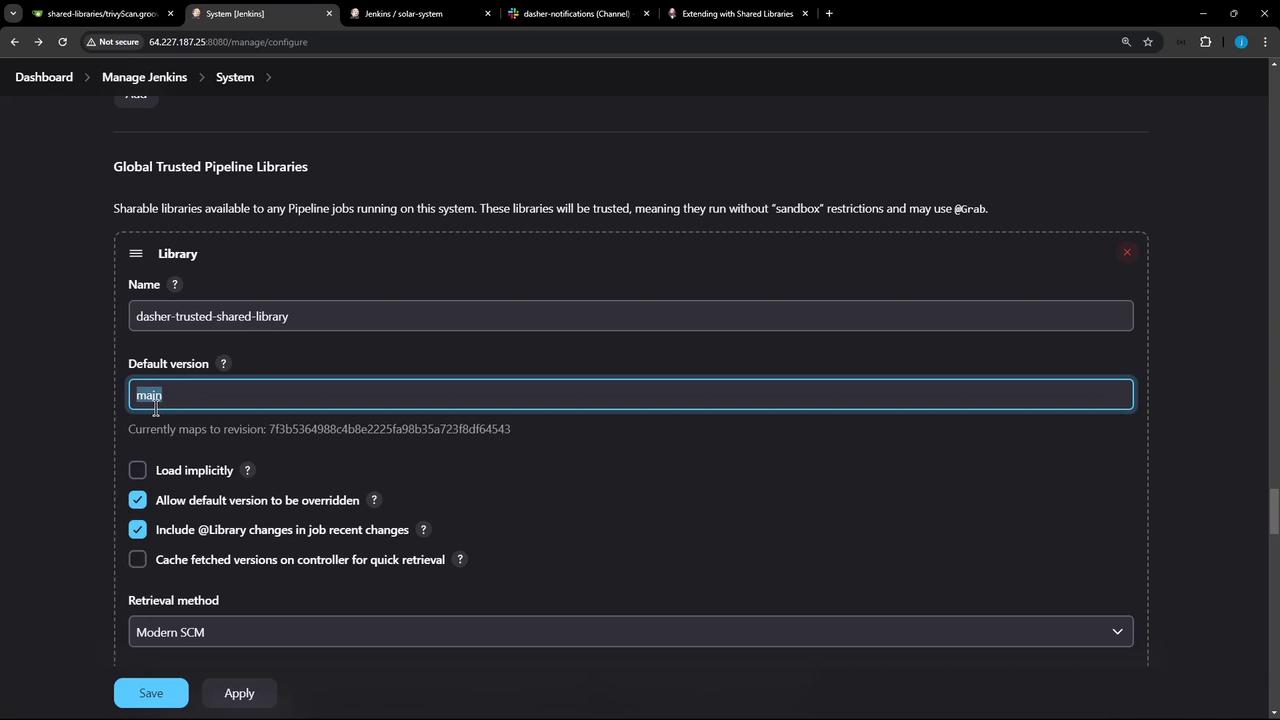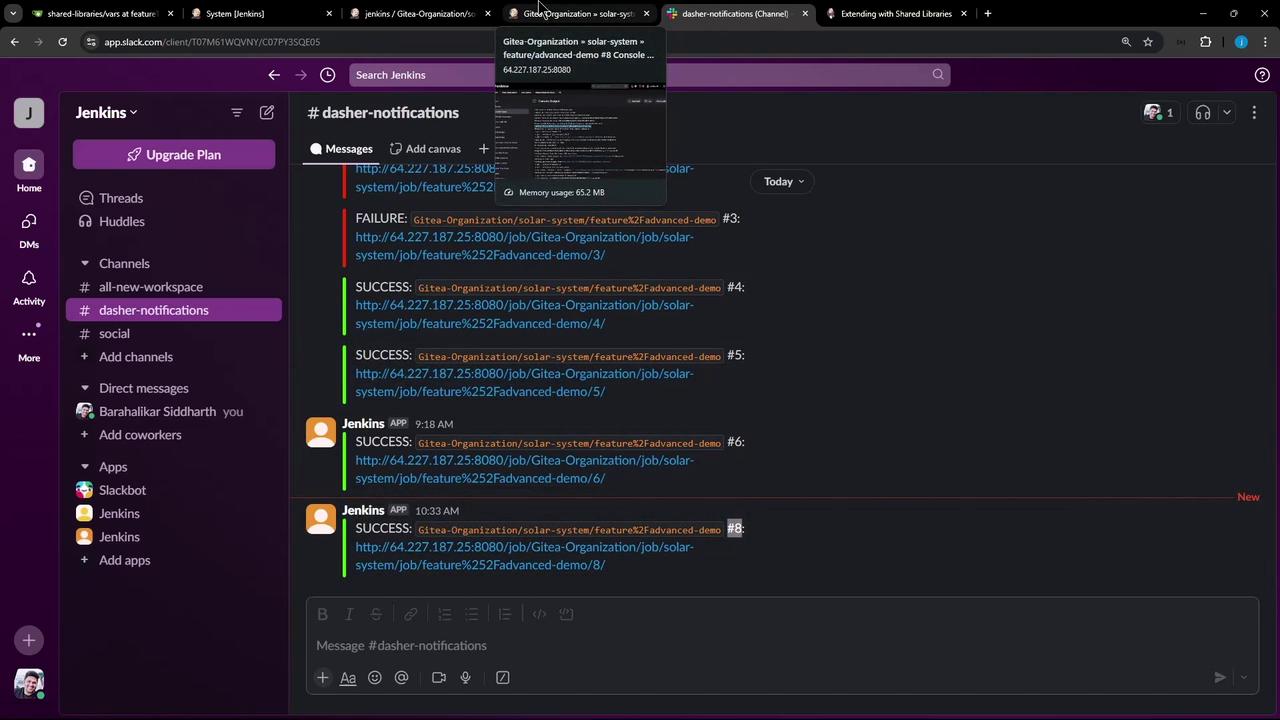Certified Jenkins Engineer
Shared Libraries in Jenkins
Demo Load TrivyScan Library in Jenkins Pipeline
In this tutorial, you’ll learn how to integrate a custom TrivyScan shared library into your Jenkins pipeline to automate vulnerability scanning and report generation. We will walk through the following steps:
- Define TrivyScan methods in your shared library
- Configure the global pipeline library in Jenkins
- Override the default library version using a feature branch
- Invoke the
vulnerabilityandreportsConvertermethods inside a declarative pipeline - Wrap library calls in
scriptblocks to comply with pipeline syntax - View generated reports and Slack notifications
1. Define TrivyScan Methods in Your Shared Library
Create vars/TrivyScan.groovy in your shared library repository with two methods:
- vulnerability: Runs Trivy image scans with different severity thresholds
- reportsConverter: Converts JSON scan results into HTML and JUnit XML
// vars/TrivyScan.groovy
def vulnerability(String imageName) {
sh """
echo "Scanning image: ${imageName}"
trivy image ${imageName} \
--severity LOW,MEDIUM,HIGH \
--exit-code 0 --quiet \
--format json -o trivy-image-MEDIUM-results.json
trivy image ${imageName} \
--severity CRITICAL \
--exit-code 1 --quiet \
--format json -o trivy-image-CRITICAL-results.json
"""
}
def reportsConverter() {
sh """
# Convert to HTML reports
trivy convert --format template \
--template "@/usr/local/share/trivy/templates/html.tpl" \
--output trivy-image-MEDIUM-results.html trivy-image-MEDIUM-results.json
trivy convert --format template \
--template "@/usr/local/share/trivy/templates/html.tpl" \
--output trivy-image-CRITICAL-results.html trivy-image-CRITICAL-results.json
# Convert to JUnit XML reports
trivy convert --format template \
--template "@/usr/local/share/trivy/templates/junit.tpl" \
--output trivy-image-MEDIUM-results.xml trivy-image-MEDIUM-results.json
trivy convert --format template \
--template "@/usr/local/share/trivy/templates/junit.tpl" \
--output trivy-image-CRITICAL-results.xml trivy-image-CRITICAL-results.json
"""
}
Commit and push on a feature branch:
git checkout -b featureTrivyScan
git add vars/TrivyScan.groovy
git commit -m "Add TrivyScan shared library methods"
git push origin featureTrivyScan
2. Configure Jenkins Global Pipeline Library
In Jenkins, go to Manage Jenkins → Configure System → Global Pipeline Libraries and add or update your library:
| Property | Value |
|---|---|
| Name | dasher-trusted-shared-library |
| Default version | main |
| Allow default version override | ☑️ Enabled |

Enabling version override allows pipelines to specify a branch or tag in the @Library annotation.
3. Load a Specific Library Version in Your Jenkinsfile
At the very top of your Jenkinsfile, reference the feature branch:
@Library('dasher-trusted-shared-library@featureTrivyScan') _
This makes the trivyScan methods available to your pipeline.
4. Invoke TrivyScan Methods in a Declarative Pipeline
Below is a sample Declarative Pipeline that:
- Builds a Docker image
- Runs Trivy scans
- Converts scan results to HTML and JUnit
- Publishes the reports
@Library('dasher-trusted-shared-library@featureTrivyScan') _
pipeline {
agent any
environment {
GIT_COMMIT = "${env.GIT_COMMIT}"
}
stages {
stage('Build Docker Image') {
steps {
echo "Building Docker image"
sh 'docker build -t myrepo/solar-system:${GIT_COMMIT} .'
}
}
stage('Trivy Vulnerability Scanner') {
steps {
script {
trivyScan.vulnerability("myrepo/solar-system:${GIT_COMMIT}")
}
}
post {
always {
script {
trivyScan.reportsConverter()
}
publishHTML([
allowMissing: true, alwaysLinkToLastBuild: true, keepAll: true,
reportDir: '.', reportFiles: 'trivy-image-*.html', reportName: 'Trivy HTML Reports'
])
publishHTML([
allowMissing: true, alwaysLinkToLastBuild: true, keepAll: true,
reportDir: '.', reportFiles: 'trivy-image-*.xml', reportName: 'Trivy JUnit Reports'
])
}
}
}
}
}
Note
In Declarative Pipelines, any method calls on shared library objects must be wrapped inside a script {} block to avoid syntax errors.
5. View Pipeline Output and Reports
Once you push your branch, Jenkins will trigger a build. In the Console Output, look for trivy image ... commands:
echo "Scanning image: myrepo/solar-system:c9dc5eb9b28174642a87fb0e2c8f92845fa4b1d"
trivy image myrepo/solar-system:c9dc5eb9b28174642a87fb0e2c8f92845fa4b1d --severity LOW,MEDIUM,HIGH --exit-code 0 --quiet --format json -o trivy-image-MEDIUM-results.json
trivy image myrepo/solar-system:c9dc5eb9b28174642a87fb0e2c8f92845fa4b1d --severity CRITICAL --exit-code 1 --quiet --format json -o trivy-image-CRITICAL-results.json
...
In Pipeline Artifacts, you’ll find both HTML and XML reports:

6. Verify Slack Notifications
If you also have a Slack notifications shared library on this branch, you should see build alerts in your channel:

Warning
Make sure your Slack token and channel are configured securely in Jenkins credentials to prevent unauthorized access.
Links and References
- Jenkins Pipeline Shared Libraries
- Trivy: A Simple and Comprehensive Vulnerability Scanner
- publishHTML Plugin
Watch Video
Watch video content